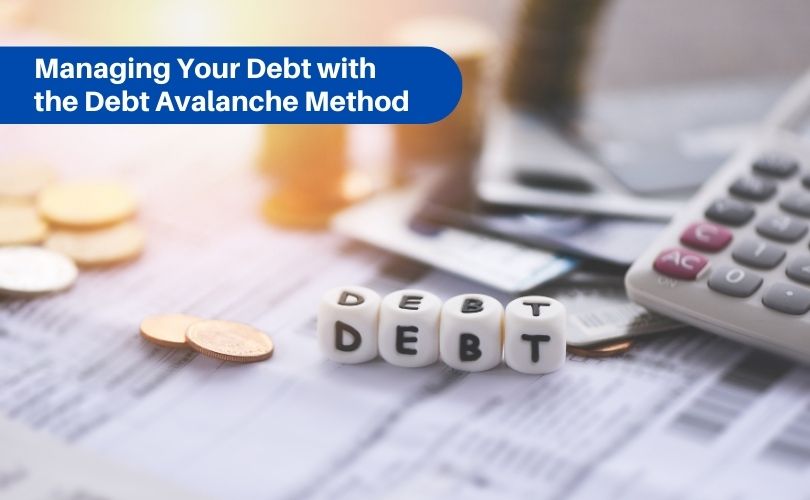

Debt is a common aspect of modern life, affecting millions of people worldwide. One effective strategy to tackle your debts is the Debt Avalanche Method. In this blog, we will explore more on this method helping you understand its concept and how it can help you regain financial control.
Basically, a debt reduction strategy that focuses on paying off high-interest debts first while making minimum payments on other debts.
The method is a popular and effective debt reduction technique that prioritises paying off high-interest bills first in order to save money and accelerate the debt-free process. It is a method that encourages people to prioritise their debts depending on interest rates in order to reduce the total interest paid over time.
• List Your Debts: Begin by listing all your outstanding debts. Include the name of the creditor, the current pending due, the interest rate, and the monthly payment.
• Sorted by Interest Rate Order: After that, sort your debts according to interest rates and order them to decrease. Keep your debts at the top of the list that contains higher interest rates. Whereas, the debt is at the bottom with the lowest rate.
• Pay Extra on High-Interest Debt: While you continue to make the minimum monthly payments on all your debts, you allocate any extra funds or additional income you have to the debt with the highest interest rate. This means you pay more than the minimum required on this particular debt each month.
• Snowball Effect: This includes paying the loan that consists of the highest interest rate, etc. You have more money available to pay down the subsequent obligation as each one is paid off. Because of the “snowball effect,” you can pay off your bills faster as you move through the list.
The key idea behind the method is to address the most expensive debts first, thereby significantly reducing the total interest paid over the long term. This strategy can save you money and provide a psychological boost as you witness visible progress in reducing your debt load. It also promotes financial discipline by encouraging you to tackle high-interest debts head-on while continuing to make minimum payments on other obligations.
The Debt Avalanche method is so effective because it tackles the most expensive debts first. By doing so, you can significantly reduce the total interest you pay over time and become debt-free faster. This approach not only saves you money but also provides a psychological boost as you see progress quickly.
Creating a budget is a critical step when implementing the method or any other debt reduction strategy. A well-structured budget helps you track your income and expenses, enabling you to allocate extra funds toward your high-interest debt efficiently. This is a detailed how-to for making a budget that works with the method:
Step 1: Compile Your Financial Data
Get all the financial data you’ll need, such as a breakdown of your debts, monthly costs, and sources of income. To construct an appropriate budget, make sure you have access to bills, bank statements, and any other financial documents.
Step 2: This includes the calculation of your monthly revenue, keeping in all your expenses like rental, freelance income, etc. If your income varies, calculate an average based on the past few months.
Step 3: List Your Monthly Expenses
• Make a comprehensive list of your monthly expenses. These may include:
• Fixed Expenses: These are regular, unchanging costs, such as rent or mortgage, insurance premiums, and car payments.
• Variable Expenses: These are costs that fluctuate month to month, like groceries, utilities, entertainment, and transportation.
Step 4: Differentiate Between Needs and Wants
Review your list of expenses and distinguish between essential needs and non-essential wants. Needs are mandatory, while wants are discretionary. This separation will help you identify areas where you can cut back to allocate more money to your debt payments.
Step 5: Set Up Categories
Organize your expenses into categories, making it easier to manage and track your budget. Common categories include housing, transportation, groceries, utilities, and entertainment.
Step 6: Determine Your Debt Paydown Goal
Set a clear goal for how much extra money you can allocate to your high-interest debt each month. This is the heart of the Debt Avalanche method – focusing on paying off the high-interest debt while making minimum payments on other debts.
Step 7: Use apps for budgeting or create a spreadsheet
You can use budgeting tools like Mint, YNAB (You Need A Budget), or Excel, or you can build a spreadsheet with your income, expenses, and debt paydown target. This will surely help you in finding out if you have a monthly deficit.
Step 8: Allocate Extra Funds
If you have a budget surplus, allocate the extra funds toward paying down your high-interest debt, following the method. This means that you make minimum payments on your other debts while putting any extra money towards the debt with the highest interest rate.
Step 9: Monitor and Adjust Your Budget
Regularly review and adjust your budget as necessary. Life circumstances can change, and unexpected expenses can arise, so flexibility is key. If your income increases or you cut back on certain expenses, consider increasing your debt paydown allocation.
Step 10: Stay Committed
Consistency is vital when following the method. Stay committed to your budget and debt reduction plan. More focus + faster progress!
Automating your debt payments is an excellent way to stay on track with your Debt Avalanche method and ensure you never miss a due date. Here’s how you can start automating payments for your debts:
1. Set Up Online Accounts:
First, make sure you have online accounts set up with your creditors. Most financial institutions and lenders offer online account access, where you can view your statements, make payments, and set up automatic payments.
2. Gather Payment Information:
Collect all the necessary payment information for your debts, including your account numbers, the creditor’s name, and the due dates. This information should be readily available on your statements or in your online accounts.
3. Link Bank Accounts:
To automate payments, you’ll need to link your bank account to your creditors’ online payment systems. This process typically involves providing your bank account information (account number and routing number) to authorize direct debits from your account.
4. Schedule Automatic Payments:
• Once you’ve linked your bank account, you can set up automatic payments for each debt. You can usually do this through your creditors’ websites or by contacting their customer service. Follow these steps:
• Log in to your online account with the creditor.
• Find the “Automatic Payments” or “AutoPay” option. This is usually under the “Payments” or “Billing” section.
• Follow the prompts to set up automatic payments. You’ll need to specify the amount you want to pay (minimum or more), the payment source (your linked bank account), and the frequency (monthly is typical).
• Ensure you select the Debt Avalanche method by specifying which debt you want to pay the minimum on and which debt you want to allocate extra funds toward.
• Verify the payment schedule, including the due date and the amount. Make sure it aligns with your budget and strategy.
5. Set Up Alerts:
Most creditors offer the option to receive email or text alerts when a payment is made. This helps in confirming your automatic payments.
6. Monitor Your Bank Account:
Regularly check your bank account to ensure that the scheduled payments are being deducted correctly. This will help you identify any issues or discrepancies promptly.
7. Adjust as Needed:
Life circumstances may change, and you might need to adjust your automatic payments. If you receive a pay raise or come into extra funds, consider increasing your payments on the high-interest debt according to the method.
Allocating extra funds with the Debt Avalanche method is a crucial step in accelerating your journey to becoming debt-free and saving money on interest. Here’s a step-by-step guide on how to allocate extra funds effectively:
Before you can allocate extra funds, you need a budget in place. Your budget should outline your monthly income, essential expenses, and minimum debt payments. The surplus from your income over your expenses will be the extra funds you can allocate.
Extra funds can come from various sources, such as bonuses, tax refunds, gifts, or income increases. Identify these sources and add the expected amounts to your budget when they occur.
Calculate the additional amount you can allocate to your high-interest debt each month. This is based on the surplus in your budget, as well as any extra funds from windfalls like bonuses or tax refunds.
Following the Debt Avalanche method, prioritize your high-interest debt over other debts. The extra funds should be directed toward the debt with the highest interest rate while making minimum payments on other debts.
To ensure that the extra funds are consistently allocated to your high-interest debt, set up automatic payments. You can easily do this through the creditors’ website.
If you have difficulty setting up automatic payments or specifying how you want the extra funds applied, don’t hesitate to communicate with your creditors. They can guide you on the best way to allocate the extra funds.
Regularly review your budget, bank statements, and debt balances to track your progress. Ensure that the extra funds are consistently reducing the principal balance of your high-interest debt.
Life circumstances can change, and your financial situation may evolve. If you receive an unexpected windfall or experience financial setbacks, adjust your allocation of extra funds accordingly. For windfalls, consider allocating a significant portion to debt paydown.
As you pay off one high-interest debt, use the funds that were previously allocated to it to tackle the next highest-interest-rate debt. This creates a snowball effect, allowing you to pay down your debts more rapidly.
The method offers several significant benefits for individuals looking to manage and reduce their debt effectively. The following are some major benefits of applying the method:
• Reduces Interest Expenses: Saving a sizable sum of money on interest payments is one of the method’s most important advantages. You can lower the total amount of interest you pay over time by giving high-interest debt priority.
• Faster Debt Repayment: The method accelerates your journey to becoming debt-free. By focusing on the highest-interest debt first, you can eliminate it more quickly, which frees up resources to tackle the next highest-interest debt. This creates a snowball effect that speeds up the entire debt repayment process.
• Psychological Motivation: Paying off high-interest debts early in the method can provide a significant psychological boost. As you see the tangible progress of eliminating individual debts, you become more motivated and confident in your ability to achieve your financial goals.
• Financial Discipline: The method encourages financial discipline and budgeting. To allocate extra funds to high-interest debt, you need to manage your finances effectively, create a budget, and stick to your plan. This discipline can have a long-lasting positive impact on your financial habits.
• Clear Debt Priority: The Debt Avalanche method provides a clear and logical order for repaying your debts. It removes any ambiguity in deciding which debt to pay off first by focusing on the most costly debts, making the decision-making process straightforward.
• Customization: The method is highly customizable to your financial situation. You can increase the amount allocated to your high-interest debt when you have extra funds and decrease it during lean months.
• Freedom from Debt: Ultimately, the most significant benefit is the potential to achieve freedom from the burden of debt. By consistently applying the method, you can work toward a debt-free life, allowing you to allocate your income toward building savings and investing for your future.
If you’re drowning in debt, the Debt Avalanche method can be a lifeline to financial freedom. The key is to act now. Begin by listing your debts, prioritizing them by interest rate, and developing a budget that allows you to allocate extra funds to your high-interest debt.






One Response
Magnificent beat ! I would like to apprentice while you amend your site, how can i subscribe for a blog web site? The account helped me a acceptable deal. I had been a little bit acquainted of this your broadcast offered bright clear idea